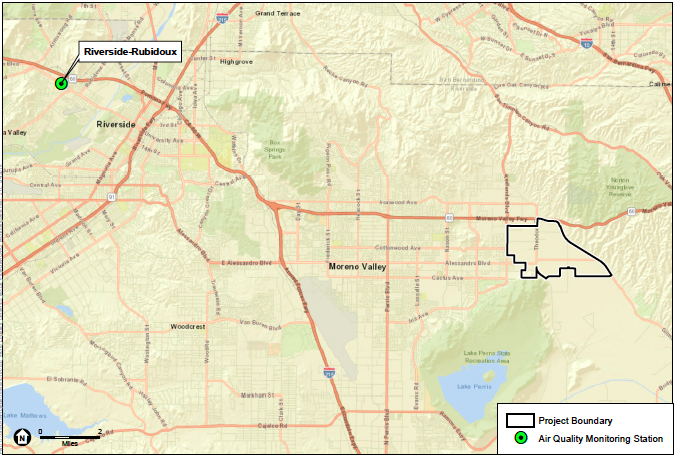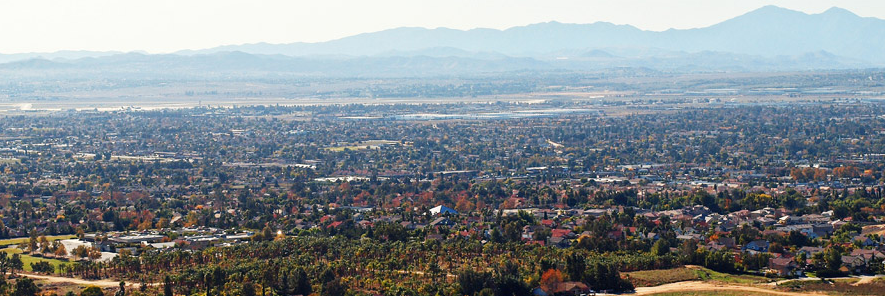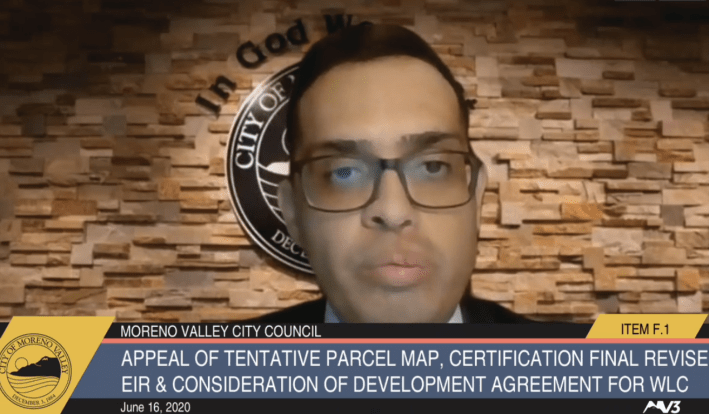Note: GJEL Accident Attorneys regularly sponsors coverage on Streetsblog San Francisco and Streetsblog California. Unless noted in the story, GJEL Accident Attorneys is not consulted for the content or editorial direction of the sponsored content.
Despite objections from state and regional agencies that it was misinterpreting state regulations, the Moreno Valley City Council recently certified an Environmental Impact Report on a megawarehouse it wants built. The council's approval brought yet one more lawsuit in a long string of legal challenges, including three from government agencies: the South Coast Air Quality Management District, Riverside County, and the Riverside County Transportation Commission.
In the course of what has been an eight-year-long argument over the proposed development, Moreno Valley city leaders have dodged and squirmed around state laws, shifted to new tactics when challenged, and rushed through a vote to certify an Environmental Impact Report that they have been warned repeatedly by multiple parties is inadequate, needs further review, and is not certifiable.
At issue is a fundamental misunderstanding - or deliberate misinterpretation of - the California Environmental Quality Act (CEQA) and the state's cap-and-trade program. The developer and city have claimed variously that they do not have to estimate, analyze, or come up with a plan to manage most of the expected emissions from the warehouse because those emissions are covered by the state's cap-and-trade program; when this assertion was challenged they said they would buy offsets through cap-and-trade to mitigate emissions. When this tactic was emphatically rejected by the California Air Resources Board and the state Attorney General as "environmentally irresponsible and legally flawed," the city responded by saying the developer would buy carbon offsets through the international carbon market, which thus rendered state objections "moot."
The cap-and-trade program and the concept of carbon offsets can be confusing, it's true, and they are hard to get exactly right without spending some time studying the issues. But the city's interpretation(s) would conveniently absolve it and the developer (Iddo Benzeevi of Highland Fairview) of all responsibility to reduce the impacts of those trips. The proposed project, called the World Logistics Center, is expected to produce some 70,000 new trips a day, 14,000 of them by diesel truck. It's exactly the nightmare scenario that community advocates warned of when cap-and-trade, and offsets, were being proposed as a "market-based approach" to fighting climate change.
Bad Air, but Oh Well
Supporters of the project hope for jobs, which are limited in this far-flung exurb from which people commute long distances. Opponents say the negative environmental and health impacts on local residents would far outweigh its benefits. The area already suffers from serious air quality problems, and adding more diesel truck trips to the mix would make those worse, affecting people's health as well as the region's ability to meet federal air quality standards, which would have cascading effects on funding, planning, and other areas of government.

Instead of taking these concerns seriously, or even discussing them, the developer began collecting signatures for an initiative to put the project to a public vote, which he believed would have allowed him to entirely sidestep the California Environmental Quality Act. In 2015, rather than put it to a public vote, the city council simply adopted the initiative. Later the court ruled their action violated the law, and threw it out.
Meanwhile, the city completed an EIR in which it made that surprising claim, mentioned above, about not having to analyze or mitigate most of the project's emissions because they were covered under California's cap-and-trade program. The project is expected to produce 400,000 tons of greenhouse gas emissions every year, but a court ruling that sent the EIR back as deficient remained silent on the greenhouse gas issue. That ruling was appealed, and a new tentative court ruling held that the developer actually does have to analyze and discuss greenhouse gas emissions. A hearing on is scheduled for early August.
Meanwhile, the Moreno Valley City Council issued a new EIR, which proposed that, if the court trashes its approach to the greenhouse gas analysis, the developer would buy offsets through the cap-and-trade program.
That's when the California Attorney General and the California Air Resources Board weighed in, saying, in short: "No, you won't." Read their letter here [PDF].
Nevertheless, the city's Planning Commission approved the new EIR in May and sent it to the City Council for certification. But they must have realized the claims about cap-and-trade weren't going to fly. Before the city council voted on it, references to cap-and-trade were removed, and instead the plan was for the developer to just buy offsets on the open market.
In the intervening days, San Diego lost a lawsuit filed against it for attempting a very similar tactic.
Nothing to See Here
On top of all this fancy footwork, city councilmembers have been the subject of multiple complaints of conflicts of interest and of having their campaigns bankrolled by the developer, Iddo Benzeevi. Moreno Valley city attorney Steve Quintanilla spent a few minutes addressing those allegations at the beginning of the City Council meeting at which the EIR was certified.
"There are no records, no evidence of any serial meetings" between councilmembers and the developer, he said. Yes, they did each meet with the developer. Just not serially.
And while the developer did contribute to their re-election campaigns, that, according to the attorney, did not equate to a conflict of interest.
"Just because one of the councilmembers may have received a financial contribution does not preclude that person from weighing in on decisions," he said. "It sounds bad and it looks bad, but it's not against the law... because if that were the case, we wouldn't have anybody making decisions at the council level," he added.
That was just the start of the meeting.
"Comments from CARB and AG Are Irrelevant"
Quintanilla went on to dismiss the letter the city had received from the Air Resources Board and the Attorney General as irrelevant, because, he said, "neither CARB nor the Attorney General are part of the CEQA process." He did not address the letter's charge that the EIR falsely claimed to have CARB's support for its approach to offsets, or that it failed to even try to address local impacts, nor that, because it added new information, it would need a new public comment period.
Instead, he merely said that "the cap-and-trade issue [raised in the letter] is moot anyway, because we're no longer considering that as mitigation. Instead we will be buying offsets from the wider carbon market."
City representatives repeatedly highlighted the benefits promised by the developer: 20,000 jobs, $2.5 billion in annual benefits, $22 million for public schools, $7 million for jobs training, $5.7 million to the general fund, $26 million to the regional air quality district, and "several million" to Riverside county and RC transportation agency for "road improvements "in and near the city." Other city estimates put the number of promised jobs at 33,000.
Mayor Yxstian Gutierrez said that if the development agreement that included these promises were not approved, "You're saying no to the kids." "If you really do care about men and women of color... then you would move this forward," he added.
City leaders did not respond to charges that the plans would do nothing to reduce local impacts from the vast majority--almost ninety percent--of the project's emissions. Instead, consultant Heidi Rous introduced two out-of-state experts on international carbon offset markets, who explained that those markets have integrity, and that buying offsets far from the source of emissions was completely legit.
Mayor Gutierrez opened the discussion by trying to limit discussion, saying that the only topics that could be commented on would be those specific ones ruled inadequate in the previous EIR.
Adrian Martinez, an attorney for Earth Justice who is leading several lawsuits against the project, including the most recent one, said that couldn't be true. The document was inconsistent, unclear, and confusing, and included significant last-minute additions, which meant everything was on the table for discussion. "You have [added] a significant impact that was not previously disclosed," he said, which is a "prime textbook argument for recirculation of the EIR."
But the city council seemed to be in a hurry to get the EIR certified. They ignored comments from people who raised objections, and dismissed opponents as "outsiders." In a Press Enterprise article, the developer's spokesperson repeated a charge made by Mayor Gutierrez that opponents are special interest groups who make a living by "suing projects in California.... They have developed a business model out of litigating nearly every project of any significance under” the California Environmental Quality Act.
Note that the California Environmental Quality Act is an unusual piece of state law, in that the only way to enforce it is by litigation - or the threat of litigation. It requires developments to conduct environmental assessments, document impacts, and propose mitigations. But if those Environmental Impact Reports are crap, and the developer can get the lead agency - say, a city council - to approve them anyway, and if no one sues within a very short period of time, then the approval stands.
Seriously. A flawed, incomplete, terrible, or utterly stupid EIR, if left unchallenged after about thirty days, will remain so, and a development can proceed unhindered by environmental concerns.
Not So Fast
Unfortunately for Highland Fairview and Iddo Benzeevi, the developer, that did not happen in this case. The latest lawsuit [PDF], from the Center for Biological Diversity, the Center for Community Action & Environmental Justice, the Coalition for Clean Air, the San Bernardino Valley Audubon Society, and the Sierra Club, was filed last week, soon after the City Council approval.
It charges that the new EIR is inadequate on several fronts, including lacking analysis of impacts, lacking consideration of potential ways to lower emissions, and lacking evidence to support the impact estimates it does make. The proposed mitigation - to buy carbon offsets for almost ninety percent of the total emissions - was no different from the one ruled inadequate in the San Diego case. And the last-minute changes to the EIR should have triggered a new review period so people had time to study it before it was submitted for a certification vote.
Note that several of the groups involved in the suit are statewide environmental groups, and several are decidedly local. The Center for Community Action & Environmental Justice, for example, is located in Riverside County, where it works to help the local community have a say on improving their environment.
"People want more information," said Ivette Torres, a research and policy analyst with the CCAEJ who is also a resident of Moreno Valley. "I hope the city council and elected officials listen, because right now they're denying some of their constituents a voice."
"This project was approved by the City Council in 2015, and there's been five years of back and forth, with different versions of the EIR, trying to move it forward," she told Streetsblog. "But it's all missing the point, because none of it addresses local impacts."
"This project is a big change for the city," she added. Even though the Inland Empire is becoming known for its warehouses, which function as storage and distribution hubs for the ports in L.A., a good eighty miles away, the proposed World Logistics Center would dwarf all the others. At 40-million-plus-square-feet, it would be big enough to contain 700 football fields, and would cover over ten percent of the city's land mass.
"But we don't even know who would move in," said Torres, and there's no consideration of what the future of the logistics industry will be, given increasingly stringent climate and clean air rules. "We should be moving towards a clean, electric future. In twenty years, will there be a lot of empty warehouses because we've had to make a shift? They're not thinking of the future," she said.
"I hope litigation isn't the only way to assess this project," she added, "but after five years, there are still a lot of questions. And if not for this litigation, many local residents wouldn't even know about the project" because there has been no public outreach by the city.
That is, what public outreach there has been seems to have consisted of invitation-only meetings with the developer, where jobs benefits are touted and contributions to re-election campaigns are made.
Dangerous Precedent
Iddo Benzeevi, Highland Fairview, and the city council could have addressed the issues of local emissions impacts at any time, but instead have diverted attention, proposed to buy offsets rather than conduct a proper analysis, attacked people who raised concerns, and made vague promises about jobs and tax revenue.
They are willing to flood the largely Latinx community living near the proposed warehouse site with many additional tons of smog and emissions every day.
Their attempts to manipulate California environmental law and the state's cap-and-trade program serve as a cautionary tale for every other city in California, as well as community and environmental advocates and anyone else concerned about climate change or breathable air. If this EIR were to pass, it could signal to developers across the state that they could simply buy their way out the California Environmental Quality Act, jeopardizing the state's climate goals and exposing already overburdened communities to vastly more pollution, stress, and health risks.
Worse, this vote (the EIR was certified on a 3-1 vote, with one abstention) was pushed through at a time when people are fully preoccupied with other life-threatening concerns including COVID, political unrest, and the threat of massive evictions. The Moreno Valley City Council probably has more pressing issues to deal with than one developer's dreams of cashing in on his land investments.
Follow Streetsblog California on Twitter @StreetsblogCal







